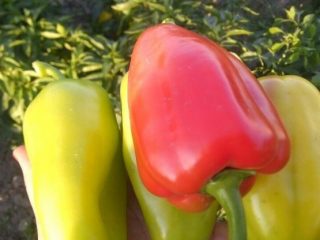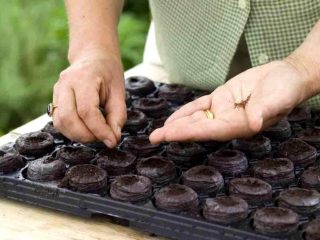Content
It would seem such a simple process - watering seedlings. But everything is not at all simple, and this matter has many of its own rules and laws. Following them will help to grow strong seedlings and get a rich harvest. In addition, proper watering helps prevent disease. pepper seedlings.
Watering before planting
This is done for the first time before the seeds are planted. After that, under no circumstances. The soil will wash away, some seeds will float, others, on the contrary, will go deeper. It is best to moisten slightly compacted soil with a spray bottle in advance. The moisture must completely seep from the surface, otherwise you will have to dig into the dirt. The soil should not be a sticky lump, but loose and moist.
There is a great way to first water before planting with snow. Melt water is very useful for all living things. Its cells have a regular, ordered shape. The benefits of melt water have long been proven, so why not use it to grow pepper seedlings. The container with the prepared soil is compacted with a layer of snow of about 2 cm, covered and placed in a warm place. When the snow melts, check the degree of moisture. The soil that is too wet is left until the morning, and the procedure is repeated with soil that is not watered enough.
Well-moistened soil at room temperature is ready, it’s time to sow pepper seedlings.
Process technology
Watering pepper seedlings is a rather delicate matter. A moisture-loving plant can die from excessive watering. There are three parameters for watering pepper seedlings:
- Amount of water depends on the capacity and age of the seedling itself. You can’t pour it so much that it overflows. Gradually and carefully moisten the soil. At the initial stage, a couple of teaspoons are enough. In transparent dishes you can clearly see where the moisture has reached, but in opaque dishes you can slightly squeeze the walls. In this case, you will feel either soft and wet earth or a dry lump. Over time, any person begins to understand how much water his pepper seedlings need.
- Watering time and frequency. How often can you water pepper seedlings: every 3 days until the leaves appear, then every day, and 2 weeks before planting in the ground 2-3 times a week. The main thing here is not to let the soil dry out; it should always be moistened. Before sprouts appear, the best way to water is to spray water from a spray bottle. Watering pepper seedlings is carried out strictly in the morning. Watering pepper seedlings at night is simply dangerous. This is a direct path to blackleg disease.
- Water quality. Tap water must be allowed to settle so that chlorine evaporates, the excess of which is very harmful to plants. The water temperature for irrigation should be about 30 degrees. Pepper seedlings love warmth; cold moisture can lead to rotting of the roots.
Moisture on the green part of the plant can lead to fungal diseases.
There is one interesting trick to increase the efficiency of irrigation.After each moistening of the soil, it is necessary to “salt” the soil surface with dry soil. You can call it micromulching. Moisture is retained in the ground, a dense crust does not form on the surface, and the delicate roots of pepper seedlings are not exposed.
Such different water
Water brings more than just nutrition to the plant. Based on the place where it was received, one can assume unpleasant contents.
Well water
Oddly enough, water from a well in most cases is not suitable for watering plants. The point is this: most wells collect water at the depth where the limestone deposits lie and below. Therefore, this water is quite hard. Watering pepper seedlings from a well can lead to alkalization of the soil, which has a very negative effect on the development of plants.
Adding a small amount of ash can help in this case. It will soften the water and at the same time saturate it with useful elements: potassium and phosphorus.
Tap water
The main problem with water supply is that it contains a significant amount of chlorine. It is added to disinfect water. That is, to destroy dangerous microbes. It’s worth thinking about: a substance that kills living organisms can harm the living organism of a larger plant? The question is rhetorical.
There is only one way out: let the water for watering the pepper seedlings sit for at least several hours. Chlorine evaporates quickly from the liquid.
Tap water contains many substances dissolved in it, for example, calcium salts, the high content of which in the soil prevents the plant from absorbing useful substances.
Solution: add ash. The content of calcium salts makes the water hard, and ash, as already mentioned, softens the water.
Another way to solve the problem is not softening, but adding acid to restore balance. It is enough to add a few grains of citric acid per liter of water to water pepper seedlings.
Melt water
Melt water acts on plants as a growth stimulator, so it would be a mistake not to use it to water pepper seedlings. Melted snow is suitable for this. You can’t heat it on purpose, otherwise all the beneficial properties will disappear. Snow melts indoors naturally, then the resulting water can be slightly heated, for example, using a radiator.
When there is no snow, you can freeze water in the freezer:
- Pour water into a plastic bottle, up to the hanger;
- Place in the freezer for 10-12 hours;
- Drain off everything that is not frozen (these are unnecessary impurities);
- Use the melted ice for watering.
Watering pepper seedlings with melt water has many positive reviews. The seedlings grow healthier and stronger, according to the testers.
Rainwater
Rainwater is practically the same as melt water. It is very soft, without any heavy particles. Collecting this life-giving moisture into rusty old barrels is simply blasphemy. Destroying all benefits. Therefore, the container must be clean, preferably non-metallic.
Using rainwater to water pepper seedlings in industrial areas can be dangerous. All substances from factory chimneys are carried tens of kilometers in the atmosphere, settling on rain clouds.
Boiled water
Using boiled water to water pepper seedlings is not recommended.During boiling, a large amount of oxygen evaporates from water. This depletes the benefits of water.
Plant roots need oxygen.
Watering with benefit
This is about how to beneficially water pepper seedlings. Water can be flavored with useful substances, not to be confused with chemical fertilizers. Such solutions cannot completely replace clean water, but alternating with mineral fertilizers is very useful.
Humates
Scientists have not yet decided whether it is a fertilizer or a growth stimulant. The mechanism of their actions also generates debate. Only one thing is clear: they bring undoubted benefits to plants.
It has been experimentally proven that the use of humates increases the resistance of seedlings in unfavorable conditions, increases the percentage of nutrient absorption and prevents the absorption of harmful compounds.
Humates are economical to use, as they are added dropwise to water. Dosages are indicated in the annotation table.
Water aeration
Water is artificially saturated with oxygen by forcing air through it. Those who have an aquarium know what we're talking about. This can be done using an aquarium aerator. This water is more beneficial for pepper seedlings than regular water. According to reviews, the plants really grow stronger and healthier.
tea water
For better growth of weak pepper seedlings, it is recommended to replace the water with an infusion of tea leaves. It is very simple to prepare: pour 300 grams of used loose leaf tea into 5 liters of water. Leave for 4-5 days.
Ash solution
This liquid will successfully replace mineral fertilizer. It contains no nitrogen, but a lot of potassium and phosphorus, which are very useful for pepper seedlings during the entire growth period, and especially during flowering and fruit set. Such watering can be alternated with nitrogen nutrition.A half-liter jar of wood ash is soaked in a bucket of water (10 liters) overnight.
Ash for feeding pepper seedlings must be obtained by burning wood, without waste. The advantage in the content of useful elements is in the ash from burning deciduous wood.
















